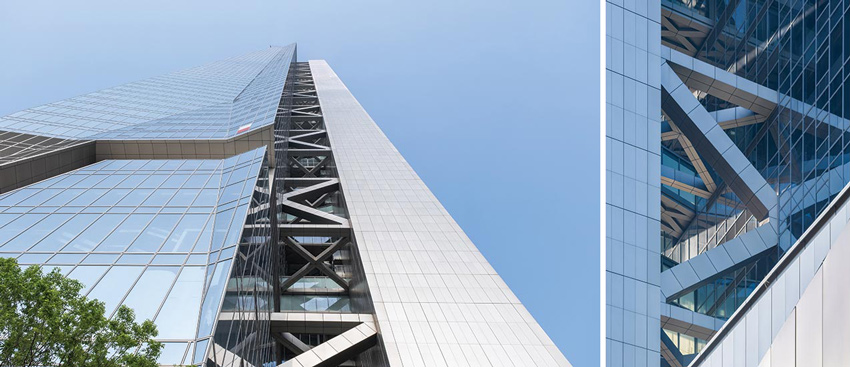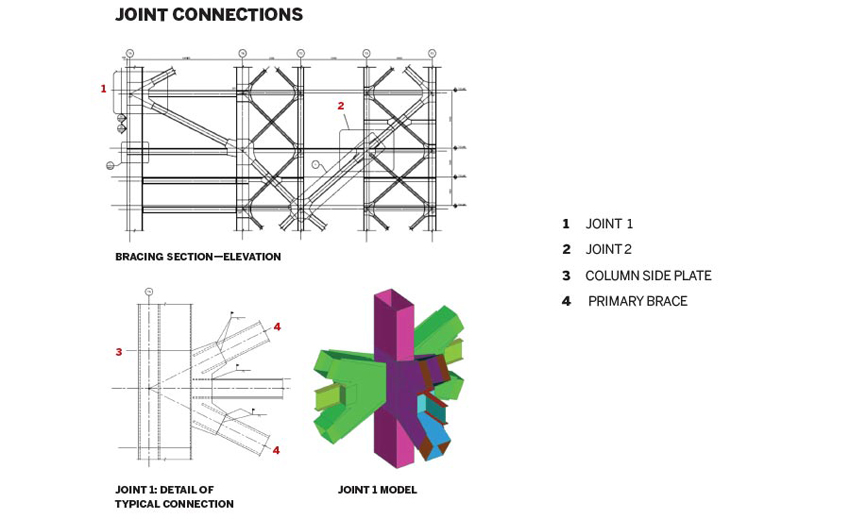Tall Buildings
Hanking Center by Morphosis Architects, Shenzhen, China
ALTHOUGH Thom Mayne and his firm, Morphosis Architects, have designed several supertall buildings (towers more than 300 meters, or 984 feet high), Hanking Center is the first one to be constructed. The firm’s earlier 985-foot-tall curvilinear Phare Tower, in Paris, of 2010, and its hotel tower for Vals, Switzerland (1,250 feet), designed in 2015, are both, so to speak, 6 feet under. So it’s good to have the 1,148-foot-high Hanking Center office tower in the Nanshan district of west Shenzhen, China, actually realized and currently filling up with office tenants. The office has entered a competitive category where Mayne can nod nicely to KPF (which has four supertalls alone in Shenzhen) and other architects he encounters during invited interviews with prospective global clients.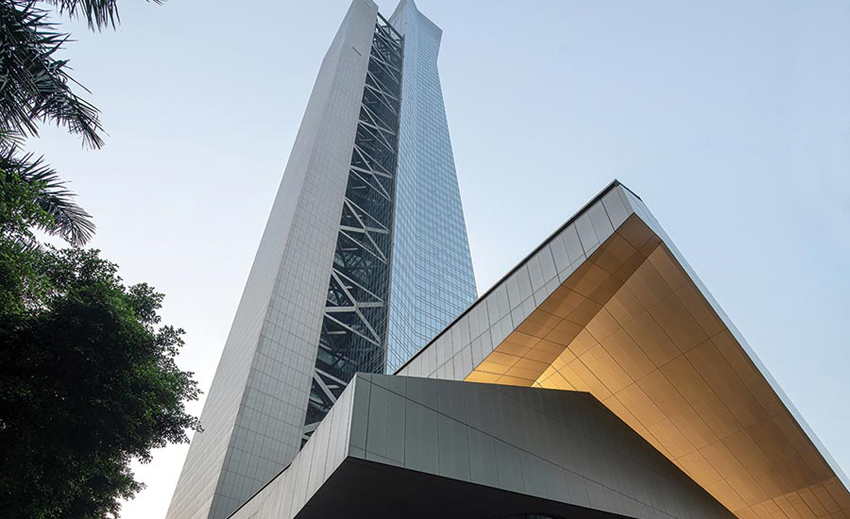
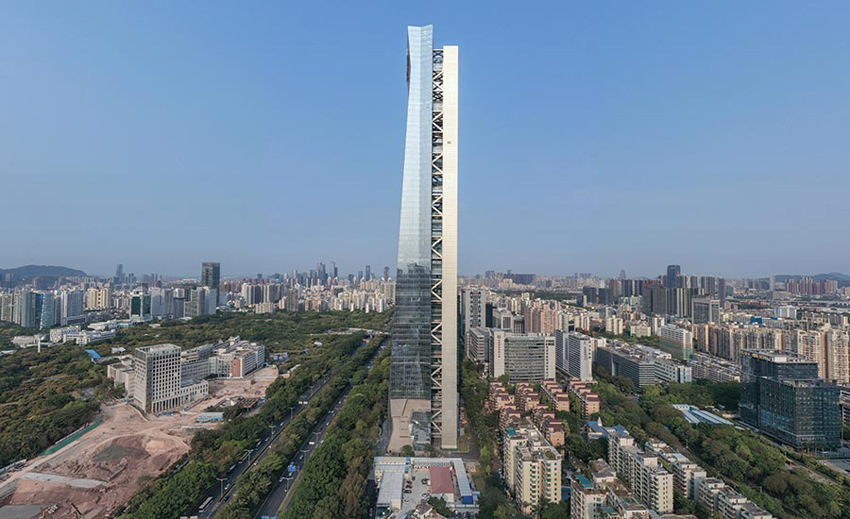
All PHOTOGRAPHY BY ZHANG CHAO
The entrance to the podium on the west (top) leads to a mix of activities.
SKINNY IS IN with a vertically bifurcated steel structure that features a low-E double-glazed main tower and an aluminum-clad detached core (above).
In the U.S., the debate continues about the value of creating more supertall buildings, with some construction slowing during the pandemic and uncertainty about the amount of office space that will be needed in major cities in the future. But in other parts of the world, the skyscraper category is vibrant, especially in China, where seven of the 10 tallest buildings currently under construction are located. In addition, “the clients are adventurous,” says Mayne. “The representative for Hanking Center said he loved the lyricism of the scheme, and he would protect us during the process.”
Mayne claims, “We don’t deal in style.” It depends on what you call style. The building has all the muscular show of force characteristic of Morphosis’s best work. The Hanking Center takes a brawny frame of steel and glass and adds an elegance to its silhouette, where the main tower is cleaved from the core. Morphosis designed a mega steel-braced frame structure for a tropical climate where typhoons and earthquakes pose challenges for tall buildings. In working out the design concept with Robert Halvorson Associates of Chicago, the structural engineer, the architects came up with a slender tower coupled with a detached core, in which elevators, services, and mechanical functions are tucked. The engineers, of course, were essential: “We had that covered with Bob Halvorson,” says Mayne.
Having a core offset from a tower has a history: Skidmore, Owings & Merrill’s Inland Steel building in Chicago of 1958, although only 332 feet high, moved the elevator core from the center of the floor to the perimeter, to provide a column-free space. Rogers Stirk Harbour did the same with the 738-foot-high Leadenhall Building in London of 2014. Hanking Center is not only taller but even farther detached, with a 35-foot gap between the main tower and its separate core, enabled by a mega brace-frame system that takes care of seismic and wind forces. In plan, Hanking’s office floors are indented on the east and west. In elevation and in section, the main tower tapers as it ascends from larger to smaller floor plates (for boutique offices), while the detached core shoots up straight as a soldier’s spine.
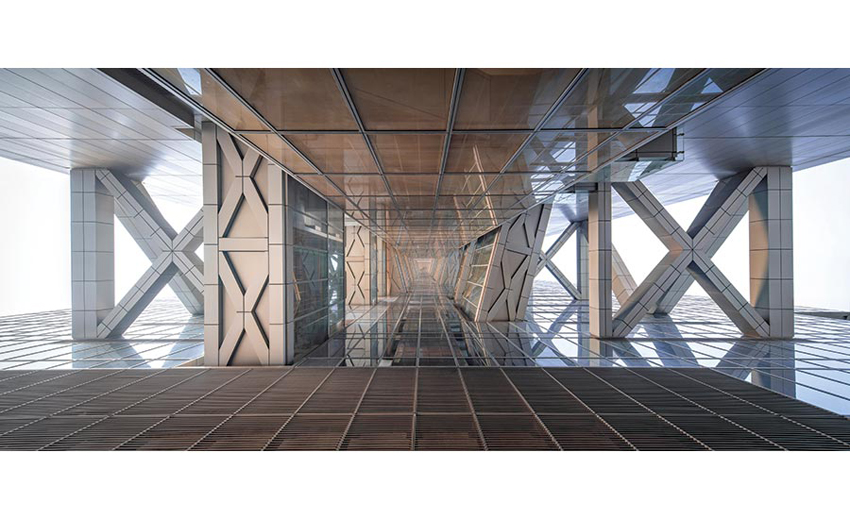
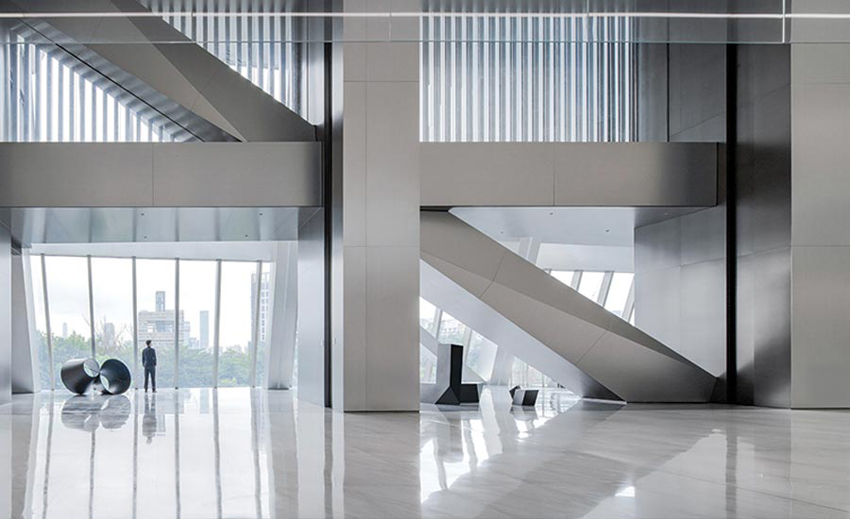
THE GAP between the main tower and the detached core, viewed looking up from a skylight in the podium, shows the drama of the mega–frame bracing (top). The office lobby in the podium looks south over the city (above).
The floors all have 270-degree views east, west, and south; only the vista on the north, where the core connects to the tower, is obstructed. Two smaller, supplementary elevator cores, inserted on the north edge of the main tower, provide additional modes of circulation—which can be useful for the privacy of visiting VIPs.
The 60 floors of offices sit on top of a 1,796-square-foot plinth with four-stories above grade and one below, for shops and restaurants. Four additional levels underground contain parking and services. Three “refuge” floors are inserted in the upper tower for fire safety.
While Zhubo Design, the architect of record, had oversight on drawings and building codes, Morphosis’s partner in charge of the project, Eui-Sung Yi, reports that “our firm did its own construction drawings”—highly unusual in China. The project took time: design started in 2012, and the core and shell were constructed by 2018, even if the interior design is ongoing.
Although steel’s ductility helped the tower meet seismic code restrictions, there was also the wind force to consider. Robert Halvorson (now retired, and whose firm has become part of WSP) points out that wind loads in Shenzhen’s location on the South China Sea are severe, with typhoons often raging between May and December, so you need to design for twice the amount of wind load common in Miami or other hurricane areas in the U.S. While concrete and composite structural systems offer twice the lateral stiffness of steel structures, the whole team favored steel for its strength and compactness, despite its being more expensive in China than concrete. The engineers arrived at a compromise—the columns have a concrete center with steel plates enclosing them. This composite solution allowed the columns to be heavier than steel alone, but lighter and slenderer than concrete. “We got approval to call it a ‘steel’ building, even with a steel/composite system for the columns,” says Halvorson. The strategy meant “welding in the field, adding to construction time, but allowed us to abide by a more reasonable lateral-stiffness code requirement and reduce material quantities, column sizes, and costs.”
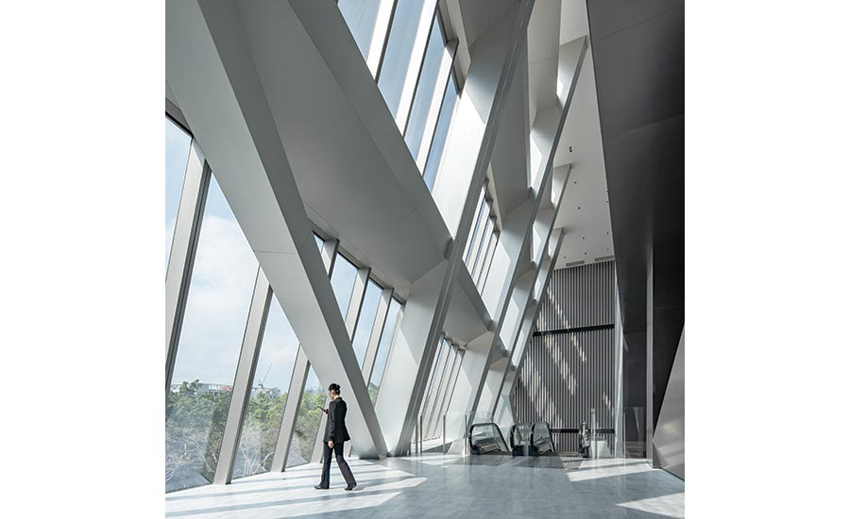

OFFICE LOBBIES on the third and fourth levels of the podium face south (top). The main entrance is on the west (above).
Other design moves helped counter seismic and wind forces. Not only are the main tower and the detached core linked by the pedestrian bridges at every floor, but the team inserted horizontal diaphragms, composed of beams and diagonal bracing, on every fourth level; they act like floor slabs linking the two structures. But—since the main building’s facades are of slightly different lengths, owing to its idiosyncratic geometry—the detailing of these bracing modules was tricky.
The pedestrian bridges linking the two structures, about 10 feet wide and 35 feet long, form an important experiential aspect of the concept. Says Mayne, “You look at the city from various sides—not only in the 270-degree view from the offices, but, when you walk across a bridge to the north, you see more of the city through solid glass. You are connected to the urban environment.” And everyone will traverse the bridges frequently, not just to use the elevators: “We even put the restrooms in the detached core,” he adds.
Since the pandemic has kept the American architects from being on the scene during the final stages of fit-out, they are waiting to see how it all came together when they visit in September, as planned. While some retail had a soft opening in September 2020, most shops and restaurants are expected to debut this fall, bringing life to the public spaces. But the rest of us will have to wait a little longer to assess the success of the bold, adventurous Hanking Center.
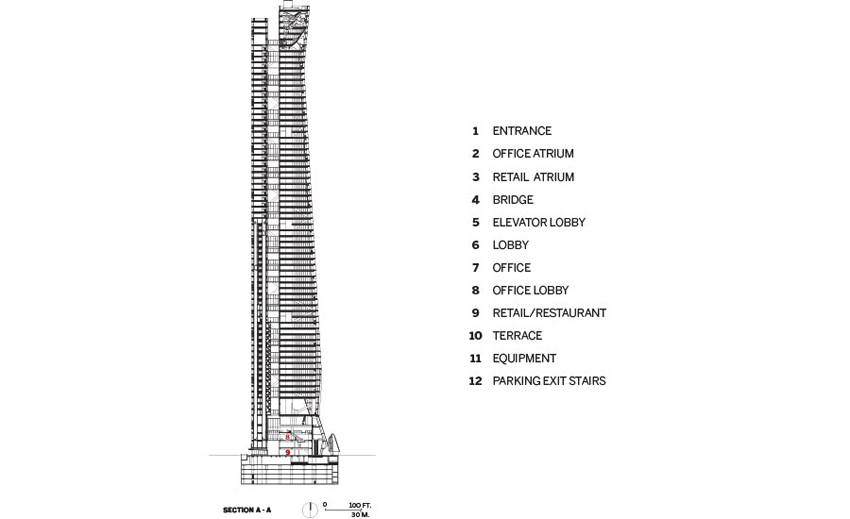
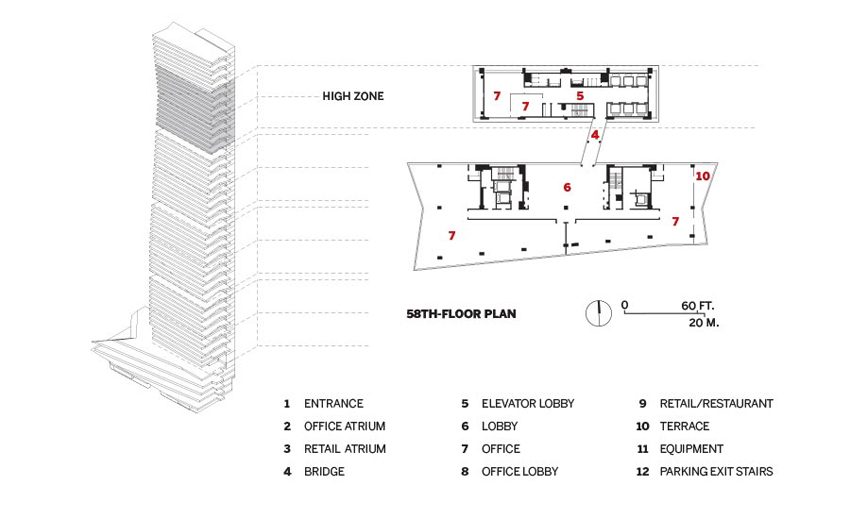
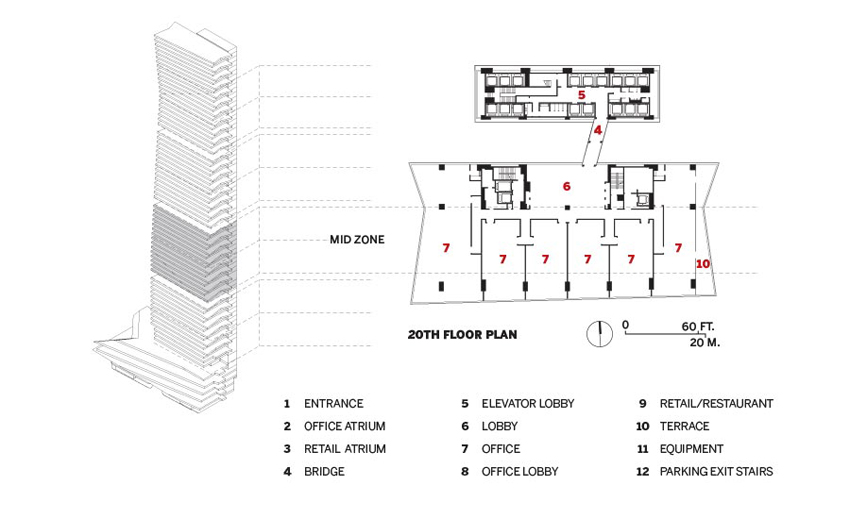
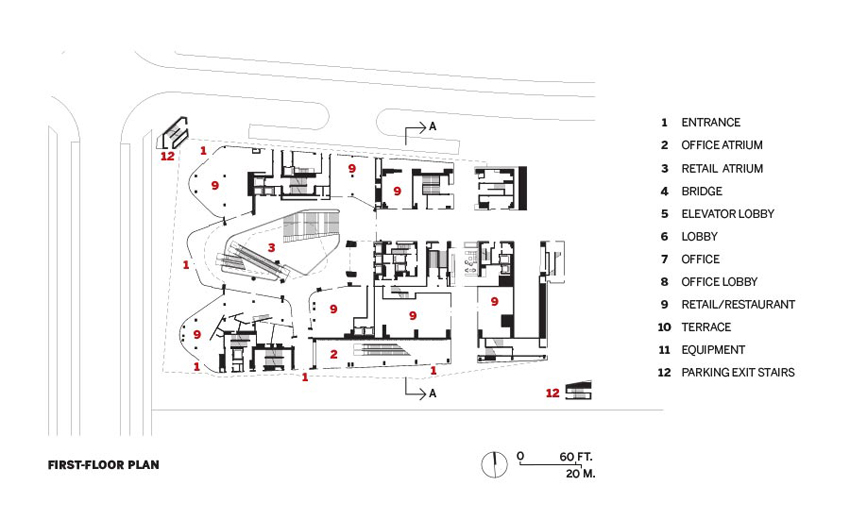
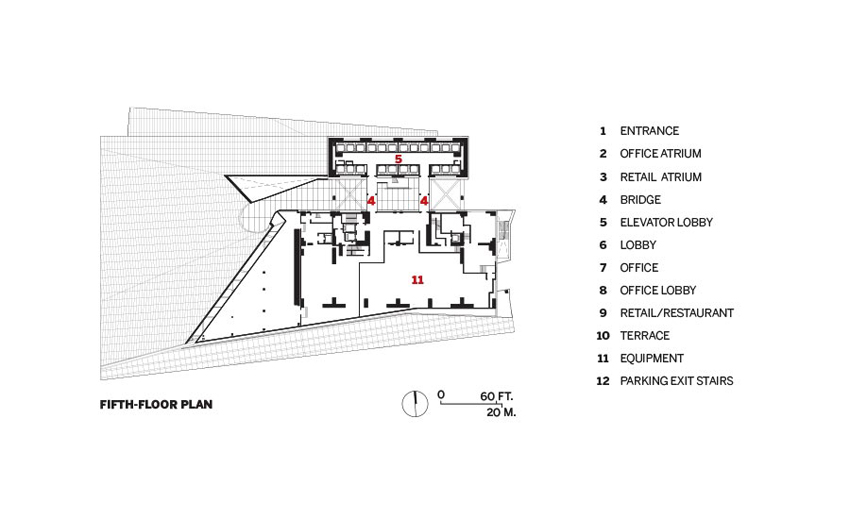
Credits
Architect: Morphosis Architects — Thom Mayne, principal and design director; Eui-Sung Yi, project principal; Hann-Shiuh Chen, project manager; Jamie Wu, Amit Upadhye, Mario Cipresso, project architectsArchitect of Record: Zhubo Design
Engineers: Halvorson and Partners (now WSP) — Robert Halvorson, principal, Patrick Ragan, engineer (structural); John A. Martin (structural concepts); Stantec (m/e/p and facade concepts); Parsons Brinckerhoff (m/e/p/fp)
General Contractor: China Construction Fourth Engineering Division Corp
Consultants: w.erk studio (general tower); RWDI (wind)
Client: Hanking Group
Size: 1.8 million square feet
Cost: withheld
Completion date: 2018 (core and shell); interior ongoing
Sources
Steel: Wuyang Steel; Xingcheng Special Steel WorksEevator: Hitachi
Paint/Coating: AkzoNobel; Hempel A/S; Jotun; PPG
Ceilings: Compton Metal Ceilings





